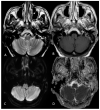Cochleo-Vestibular Disorders in Herpes Zoster Oticus: A Literature Review and a Case of Bilateral Vestibular Hypofunction in Unilateral HZO
- PMID: 37834852
- PMCID: PMC10573329
- DOI: 10.3390/jcm12196206
Cochleo-Vestibular Disorders in Herpes Zoster Oticus: A Literature Review and a Case of Bilateral Vestibular Hypofunction in Unilateral HZO
Abstract
The varicella-zoster virus (VZV), a member of the Herpesviridae family, causes both the initial varicella infection and subsequent zoster episodes. Disorders of the eighth cranial nerve are common in people with herpes zoster oticus (HZO). We performed a review of the literature on different databases including PubMed and SCOPUS, focusing on cochlear and vestibular symptoms; 38 studies were considered in our review. A high percentage of cases of HZO provokes cochlear and vestibular symptoms, hearing loss and vertigo, whose onset is normally preceded by vesicles on the external ear. It is still under debate if the sites of damage are the inferior/superior vestibular nerves and cochlear nerves or a direct localization of the infection in the inner ear. The involvement of other contiguous cranial nerves has also been reported in a few cases. We report the case of a patient with single-side HZO presenting clinical manifestations of cochleo-vestibular damage without neurological and meningeal signs; after 15 days, the patient developed a new episode of vertigo with clinical findings of acute contralateral vestibular loss. To our knowledge, only three other such cases have been published. An autoimmune etiology may be considered to explain these findings.
Keywords: Ramsay Hunt syndrome; bilateral cochleo-vestibular damage; facial palsy; hearing loss; herpes zoster oticus; magnetic resonance imaging; vestibular disorders.
Conflict of interest statement
The authors declare no conflict of interest.
Figures






References
-
- Muecke M., Amedee R.G. Herpes zoster oticus: Diagnosis and management. J. La. State Med. Soc. 1993;145:333–335. - PubMed
Publication types
LinkOut - more resources
Full Text Sources

